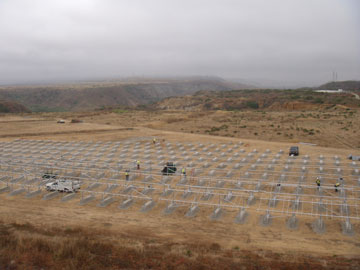Marine Base Adds Solar Arrays Atop Landfill

CAMP PENDELTON, Calif. — A nearly completed $9 million, 1.5-megawatt solar installation situated atop six acres of old landfill at the Marine Corps Base Camp Pendleton in San Diego County has been designed with ballasted foundations so as not to perforate the membrane covering the garbage below.
The Camp Pendleton installation is one of the largest photovoltaic systems funded by federal stimulus dollars in San Diego County. The 6,000-plus solar panel installation was designed by global architecture and engineering firm AECOM Technology Corp. and is being installed by San Diego-based electrical contractor Synergy Electric. The solar system is part of a Navy goal to generate 25 percent of its energy from renewable sources by 2025.
But engineers were still left with the problem of how to install 6,000 solar panels on the top of a landfill. Enter Oldcastle Precast, based in Auburn, Wash., which was able to offer a solution for the designers of the mammoth project.
“When they retire a landfill, they put a membrane over it and the membrane should never be penetrated,” explains Mike Flick, VP of Sales and Marketing for Oldcastle Precast, the company that supplied and installed the pre-cast foundations for the Camp Pendleton project.
“Not matter what you do on that landfill, it’s a big no-no to try and excavate or to punch through that surface,” he adds. “After a landfill has been filled in and isn’t in use any more, a lot of people try to use that acreage to create solar on top.”
Oldcastle’s pre-cast solar panel ballasted foundations allow the solar panels to sit aboveground without requiring digging into the earth.
“We were able to take those pre-cast pieces and put them at grade without disturbing the soil and without having to penetrate that cap, which can be close to the surface or down two or three feet,” Flick says. “With landfills, we’ve been very successful using ballasted foundations. Other projects that could use this type of system include situations where the bedrock is located close to the surface and it’s impossible to drill downward.”
“This system, when it goes on line, hopefully in December, will effectively triple or quadruple the photovoltaic power we’re generating on this base in one fell swoop,” says Col. Gary Storey, head of energy management at Camp Pendleton. “We actually have a follow-up project next year to double that capacity on this site.”
The follow-up project will mirror the installation currently under construction, says Leo Zapata, a site superintendent with Synergy Electric. Phase II will also sit on the landfill.
